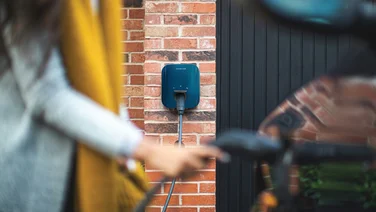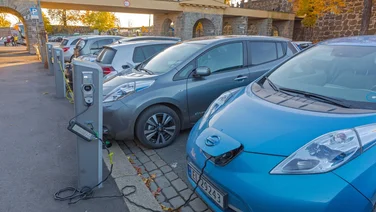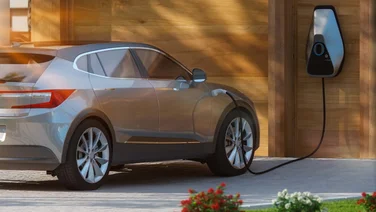- What’s on this page?
- What is the Congestion Charge?
- Do electric cars need to pay the congestion charge?
- Do electric cars need to pay the ULEZ charge?
- How does this compare to petrol and diesel cars?
- How to register your electric car for the congestion charge
- Will electric cars have to pay the Congestion Charge in the future?
- How many electric vehicles are there in London?
- Next steps
✔ The Congestion Charge is £15 a day
✔ Electric or hydrogen-fuel-cell vehicle owners can avoid these fees
✔ The charge only applies to a small area of central London
In a bid to reduce emissions, London Mayor Sadiq Khan has tightened measures on the Congestion Charge Zone. But if you own an electric vehicle, this might not affect you (though you might want to start researching how much it’d cost to install an electric car charger).
Scroll down to find out how you can swerve this fee.
If you have an electric vehicle and are ready to install a home charger, use our easy-to-use comparison tool to shop around for the best installation quote. Simply provide a few details about your home, and we’ll pass them on to our expert installers.
Get free EV charging point quotes
Answer a few quick questions, and our trusted installers will send you bespoke EV charging point quotes – for free.

What’s on this page?
What is the Congestion Charge?
The Congestion Charge is a daily fee for anyone entering the Congestion Charge zone – an area in central London, which we’ve outlined in the map below.

The Congestion Charge was first introduced in 2003, and its main goal is to reduce traffic levels in central London, making walking and cycling in the area much safer and the bus network more reliable.
The Congestion Charge zone is managed by Transport for London (TfL), and runs from 7:00am–22:00pm every day – except on 25 December. The zone is monitored by cameras, which check whether cars entering the area between these times have paid the fee.
How much is the Congestion Charge?
Before the pandemic, the Congestion Charge only cost drivers a daily fee of £10.50 if they paid by AutoPay, and £11.50 if they paid another way. However, the charging rate was increased to £15 a day in June 2020, to reduce congestion during the pandemic.
Although the government stated that this was a temporary change, there are now ongoing debates about whether this increase should continue, to help reduce emissions in the capital.
“Coronavirus continues to present our city with unprecedented challenges, but I am determined to ensure that we emerge from this pandemic with a cleaner, greener and more sustainable transport system” – London Mayor Sadiq Khan
Tempted to sneak past the cameras and avoid paying? It’s probably best not to try this, as it could land you with a £160 fine – reduced to £80 if you pay it within 14 days.
Do electric cars need to pay the congestion charge?
Electric or hydrogen-fuel-cell vehicle owners can avoid paying any Congestion Charge fees by applying for the Cleaner Vehicle Discount.
To be eligible for the scheme, drivers need to prove that their car is electric or hybrid by either providing images of the vehicle or sending photocopies of the following documents:
- UK-registered vehicles – V5C vehicle registration certificate (logbook) issued by the DVLA
- Non-UK registered vehicles – The vehicle registration document issued by your vehicle licensing agency
If you decide to go down the document route, make sure it clearly states that the vehicle is registered as fuel type ‘battery electric’ or ‘hydrogen fuel cell’.
The application for the Cleaner Vehicle Discount costs £10 per vehicle and needs to be renewed every year – a small price to pay to avoid daily charges.
Do electric cars need to pay the ULEZ charge?
Electric cars can also swerve the London Ultra Low Emission Zone (ULEZ) charge, avoiding a further £12.50 a day on top of the Congestion Charge.
The London ULEZ charge was first introduced in April 2019, but expanded further in October 2021 – now covering every borough inside the A406 North Circular Road and the A205 South Circular Road.
Sadiq Khan has also suggested that he wants to expand the area to cover the whole of London at some point in the next few years – but no plans have been confirmed yet.
Drivers need to make sure their vehicle meets a minimum emissions standard to avoid paying the charge. You can double check this on the TFL website.
The daily charge is £12.50, and if a driver doesn’t pay this in the time required, they’ll receive a penalty of £160. This is reduced to £80 if paid within 14 days.
How does this compare to petrol and diesel cars?
If you find yourself travelling into the Congestion Charge zone regularly, swapping a petrol or diesel car for an electric or hybrid one will save you heaps of money.
But just how much money can you save?
Well, the average person travels 6,800 miles annually. If you’re driving these miles with an electric car – which typically costs 9p per mile (as of July 2023)– you can expect to spend £582 a year on running costs.
A petrol car, on the other hand, will cost you lots more to run. While petrol prices have gone down to 19p per mile this year, that still tots up to around £1,297 a year.
This means that, on average, electric cars are twice as cheap to run as petrol cars.
On top of all this, Londoners can save even more money by getting themselves the Cleaner Vehicle Discount. For people travelling into the Congestion Charge zone every day – whether that’s because you live in or around the area, or drive there for work – it’ll cost you £5,460 a year.
So, overall, driving an eco-friendly car in central London could save you roughly £6,175 a year – and that’s not taking into account the amount of money you’d save from avoiding ULEZ charges.
Despite these benefits, only 55% of people would have an EV if it were free, according to our National Home Energy Survey.

How to register your electric car for the congestion charge
But before you start boasting to your petrol-driving friends that you can drive in London for free, there’s a bit of admin to do.
EV drivers need to register their car as ‘zero emission’ before they can drive inside the Congestion Charge zone free of charge. This will cost £10 to register – and will need to be done every year, if you want to continue driving in central London – but that’s cheaper than the daily fee.
You can register your electric car for the Cleaner Vehicle Discount on the TFL website – you just need to create an account before you can get the ball rolling.
Will electric cars have to pay the Congestion Charge in the future?
EV and hybrid car owners can avoid the Congestion Charge fees for the time being. However, the government has stated that as of December 2025, all vehicle owners (unless they have another discount or exemption) will need to pay to enter the Congestion Charge zone.
Why are there plans to axe the discount further down the line? Well, the government is currently pushing for greener transportation – and one way to do this is to incentivise drivers.
However, as electric vehicles get more popular over the next few years, central London will become busier, as more people swerve the fee thanks to the Cleaner Vehicle Discount. This will effectively make the Congestion Charge pointless.
How many electric vehicles are there in London?
London is one of the UK’s electric vehicle hotspots. As of June 2021, there were 70,200 ultra-low emission vehicles (ULEVs) registered in London, which includes battery-electric vehicles, hybrid-electric vehicles, and hydrogen-fuel-cell vehicles.
But how are different regions in the UK performing when it comes to the number of green vehicles – and how does London compare? Check out the chart below to find out.
Data from Department for Transport Statistics
As you can see, London is currently sitting snugly in third place, behind the South West and slightly in front of the North West. Not too bad considering London’s competing with whole regions, right?
Well, when you compare the number of ULEVs to the total population, London’s rates are slightly less impressive, since the city has a far larger population than the likes of Wales, for example.
To get a better idea of how many people are buying ULEVs around the country, we’ve calculated the number of eco-friendly vehicles per 100,000 people on the chart below.
Next steps
UK transport is gradually becoming electrified – a trend that is only set to increase in the coming years. Records were broken as recently as September 2021, when nearly 33,000 pure electric cars were registered – almost 50% more than in September 2020.
Considering hopping on the electric vehicle bandwagon? One way to make your life easier with an EV is to invest in a home charging station – simply plug it in when you get home and chill out whilst it charges.
Luckily, we can help you get the best charging station for your home. All you have to do is pop a few details in our easy-to-use quote tool, and let us do the rest. We’ll put you in touch with our professional installers, who will let you know their best quotes to compare.
You’ll be saving money – and the planet – in no time!






